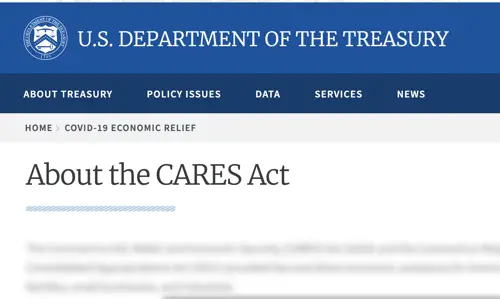Background on The Employee Retention Credit
Published:The Cares Act was developed to stimulate the economy, partly by injecting capital into small businesses so that they would continue to grow and more importantly, not lay people off because of concerns they could not afford to pay employees. So Congress encouraged businesses to keep people employed by creating incentives for them to do so.
The Cares Act created both PPP loans and the Employee Retention Tax Credit at the same time.
The PPP (Paycheck Protection Program)
PPP allowed a business to take out a loan that was forgiven so long as the loan was used to pay certain expenses, like wages. Sounded too good to be true, right? Well Congress created that program and they also created a second program, the Employee Retention Credit.
The ERC (Employee Retention Credit)
Original Version: Very Limited ERC
The first iteration of the ERC said, in order to qualify, your company must have experienced a 50% drop in gross receipts in either Quarter 2, 3, or 4 in 2020 (as 2020 Q2 was the inception of the Cares Act), compared to the same quarter in 2019. So, if your quarter 2 2020 gross receipts were 50% lower than they were in Q2 2019, you were deemed qualified to receive up to 50% of the first $10,000 in wages that you paid to each one of your W2 employees in the form of a payroll tax credit. Basically, a refund or rebate on payroll taxes based on a percentage of wages that you paid. So if you didn’t pay more than $5,000 in payroll taxes for an employee, you may actually get more money back in the payroll tax credit than you even paid in wages.
Originally, the two programs were mutually exclusive; you could only receive one OR the other, but not both. Everyone went with PPP as it was more attractive because it was a loan that you didn’t have to pay back, whereas ERC required a 50% drop in revenues to qualify in the first place, and then the benefit was to pay $10,000 and receive up to half of it back in a payroll tax credit … given the choice, everyone took PPP.
… Many CPAs advised their client’s to take PPP and moved on as that meant you couldn’t get ERC AT THAT TIME.
Get a Free Consultation Now!
Get a Free Consultation Now!
Version 2: 12/27/22 Changes – Extended and Expanded ERC
Through the next year, the ERC was amended twice through the Consolidated Appropriations Act (CAA) – Trump, and later, the Infrastructure Act – Biden. These amendments made the following changes:
(1) It extended ERC eligibility through 3rd quarter 2021. Congress could have killed the ERC program, but instead they extended it because it was good for small businesses as a framework to get them stimulus money.
(2) Next, lawmakers ended the mutual exclusivity of PPP and ERC. Now, you could receive both PPP and ERC, you just could not double dip. So, when calculating the ERC, after adding up all the wages paid, you must subtract off any portion of the wages that were paid using your PPP loan before finalizing the ERC calculation. However, even after doing that, often, plenty of wages are left against which you can claim the ERC.
(3) Next, the amendments increased the size of what constitutes a “small eligible employer”
2020 → no more than 100 W2 Full-time employees in 2019 (part-time employees do not count)
2021 → as many of 500 W2 full-time employees in 2019
That is to say, if you had less than 500 full-time employees in 2019, you may be eligible for the ERC.
(4) It also changed the revenue qualifier so that a business only needed to demonstrate a 20% drop in gross receipts vs. the same quarter in 2019 as opposed to a 50% drop.
(5) The changes also said that you could receive up to 70% of the first $10,000 in wages paid to an employee in the form of a payroll tax credit; so $7,000 per W2 employee instead of just $5,000 per W-2 employee maximum.
(6) Finally, and most importantly, you could receive ERC for EACH quarter of the first three quarters in 2021 that you experienced that 20% drop, as opposed to just receiving a maximum of $5,000 for all of 2020. So, you could receive a maximum of $7,000 per employee, per quarter, for three quarters in 2021 = $21,000 + $5,000 for 2020 = up to $26,000 per employee). Now you understand the math behind the $26,000 number that you hear all over the place.
Now we’re at 12/27/20. That’s the second iteration of ERC. But you still needed a 20% drop in gross receipts, so many CPAs told their clients, “You didn’t have a 20% drop in gross receipts OR you got PPP, you don’t qualify”.
Thankfully, that’s not when the story ends.
Version 3: Creation of Nominal Business Impact Analysis
In March of 2021, the IRS handed down IRS Notice 2021-20. Here is a brief explanation of how tax law is created and evolves in the United States.
1) The first way tax law is created is, Congress passes statutes, such as the Internal Revenue Code or the CARES Act. Laws have plain language. That’s what you call “the black letter of the law”. CPAs are really good at reading the plain language of the statutes, which, in this case, said that if you had a 20% drop in gross receipts, you were entitled to the ERC.
2) But, we also know that Congress often passes laws that are ambiguous or open to interpretation. When Congress passes a law that is ambiguous or open to interpretation, the administrative agency tasked with applying and enforcing the law is granted discretion to apply a reasonable interpretation to those ambiguous portions of the law so that they can do their job applying and enforcing the law. If Congress doesn’t like the way the administrative agency is interpreting the law, they can go through the long and arduous task of amending the statute to reign in the agency’s interpretation.
The IRS (which is an administrative agency) is tasked with the enforcement of the various statutes to control tax liabilities. In March of 2021 they set forth IRS Notice 2021-20, which sets forth 103 pages of IRS formal written guidance on their interpretation of the various laws that control eligibility for the ERC.
IRS Notice 2021-20 said, in summary, that the IRS interpreted the statutes (ie the Cares Act, CAA, Infrastructure Bill) to mean that THERE WERE TWO WAYS TO QUALIFY for the ERC:
(1) Revenue Reduction Test: No interpretation is done here. The IRS is simply restating what the statute says in plain language; that a 20% reduction in gross receipts versus the same quarter in 2019 automatically qualifies you for the ERC, OR (even in the absence of a revenue reduction);
(2) Nominal Impact analysis: Based on a company’s facts and circumstances, if a government mandate or order caused a partial or full suspension of operations that resulted in greater than nominal impact on those business operations, you also qualify for the ERC.
There are three clauses here, so let’s break it down:
a. A government order or mandate…
-An order, law, proclamation, statute, mandate handed down by any government authority (federal, state, county, or local) that says you can or cannot engage in certain behaviors because we are in the middle of a pandemic. In other words, it can’t just be a CDC recommendation (e.g., wear a mask). It can’t be voluntary actions (e.g. we decided to close shop). This is pretty plain language. We all know what a government mandate is.
2. ….that caused a partial or full suspension of business operations…
-You don’t have to be completely shut down, but normal operations must be at least partially suspended. So, you had to modify the way you were operating prior to the government order or mandate that caused a change to your operations. The mandate could have ordered you to change or it may have forced other industry changes that indirectly impacted you. You were operating one way, a government order went into place, the result of which is you had to partially suspend your current operations.
3. ….and resulting in greater than just nominal impact.
– What is a nominal impact? IRS Notice 2021-20 says on page 28, first paragraph, a nominal business impact is determined by examining the operations that were partially suspended or fully suspended in 2021 and comparing them to those same operations as they existed in 2019, and if in 2019 those operations were responsible for generating more than 10% of the companies gross revenues OR if more than 10% of the employees service hours were dedicated to those operations in 2019, then an impact to those operations in 2021 is considered to be greater than nominal.
The IRS provides about 60 different hypotheticals that are designed to provide business owners with guidance on whether their facts and circumstances may qualify them for the ERC. It kind of reads like a law school exam. “Employer A had the following facts and circumstances: Were they subject to a government order? Did it cause a partial suspension of operations? Did the partial suspension result in greater than a nominal impact? And, if you read the answers to the hypotheticals, provided by the IRS, they can help you to determine if you qualify for the ERC.
- Did you experience…..
- Partial or full shutdown per government mandates
- Restrictions on number of people in room or building
- Inability to attend normal networking events and functions such as professional conferences
- Disruption to sales force’s ability to function normally
- Supply Chain Interruptions
- Inability to access equipment
- Limited Capacity To Operate
- Inability to work with vendors
- Reduction in services or goods offered to customers
- Cut down in hours of operation
- Shifting hours to increase sanitation of facility
- Projects were canceled or delayed to COVID-related disruptions
- Delayed production timelines caused by supply chain interruptions.
- Other
If so, you may qualify for the Employee Retention Tax Credit and you may want to consider speaking with a tax attorney today to find out if you may be eligible for the credit. The credit may be worth as much as $26,000 per W-2 employee you paid during certain periods of the pandemic. Maybe you qualify or maybe you don’t, but getting educated about the law is the best way to find out.



